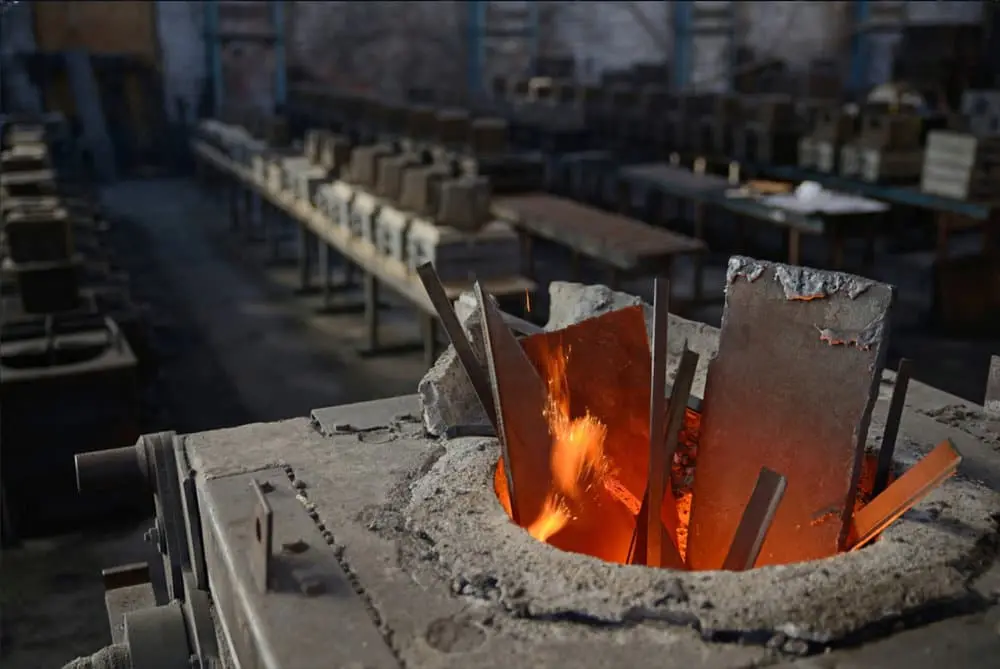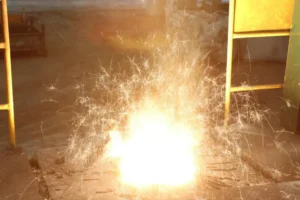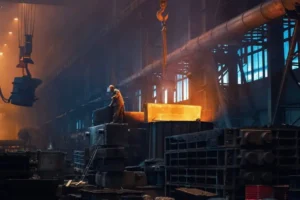เป็นเทคโนโลยีการถลุงโลหะที่มีประสิทธิภาพและสะอาดสูง, เตาเหนี่ยวนำมีบทบาทสำคัญในอุตสาหกรรมโลหะวิทยาและการหล่อสมัยใหม่, ด้วยหลักการทำความร้อนแบบเหนี่ยวนำแม่เหล็กไฟฟ้าที่เป็นเอกลักษณ์. ตั้งแต่เหล็กและวัสดุเหล็กกล้าจำนวนมากไปจนถึงโลหะมีค่าชั้นดี, การใช้เตาเหนี่ยวนำครอบคลุมภาคส่วนต่างๆ ของการแปรรูปโลหะ. อย่างไรก็ตาม, ปรับให้เหมาะกับคุณสมบัติทางกายภาพและเคมีที่แตกต่างกันของโลหะชนิดต่างๆ, ประเด็นทางเทคนิคและความท้าทายที่ต้องเผชิญระหว่างกระบวนการถลุงก็แตกต่างกันอย่างมากเช่นกัน.
ถลุงเหล็กหล่อ: ศิลปะแห่งการรักษาสมดุลระหว่างต้นทุนและคุณภาพ
เตาเหนี่ยวนำได้กลายเป็นอุปกรณ์หลักในการผลิตเหล็กหล่อ, โดยเฉพาะเหล็กหล่อคุณภาพสูง. ข้อดีของมันคือความเร็วหลอมละลายที่รวดเร็ว, การควบคุมอุณหภูมิที่แม่นยำ, และง่ายต่อการปรับองค์ประกอบของโลหะหลอมเหลว.
จุดทางเทคนิค
- การจัดการค่าธรรมเนียมและการแบ่งสัดส่วน: เพื่อรับประกันประสิทธิภาพขั้นสุดท้ายของเหล็กหล่อ, มีข้อกำหนดที่เข้มงวดสำหรับสัดส่วนและคุณภาพของวัสดุประจุ เช่น รางวิ่งและไรเซอร์, เศษเหล็ก, เหล็กหมู, คาร์บูไรเซอร์, และเฟอร์โรซิลิคอน. สัดส่วนการใช้เศษเหล็ก, โดยเฉพาะอย่างยิ่ง, ส่งผลโดยตรงต่อการใช้พลังงานและคุณภาพทางโลหะวิทยาของเหล็กหลอมเหลว.
- การหลอมละลายอย่างรวดเร็วและความร้อนยวดยิ่ง: เตาเหนี่ยวนำสามารถเพิ่มอุณหภูมิของเหล็กหลอมเหลวให้สูงกว่า 1,500°C ได้อย่างรวดเร็ว. การให้ความร้อนยวดยิ่งที่มีประสิทธิภาพช่วยขจัดพันธุกรรมของกราไฟท์และส่งเสริมการก่อตัวของกราไฟท์ประเภท A, จึงช่วยปรับปรุงคุณสมบัติทางกลของการหล่อ.
- การบำบัดด้วยการฉีดวัคซีน: นี่เป็นขั้นตอนสำคัญที่กำหนดประสิทธิภาพของเหล็กหล่อ. การเติมหัวเชื้อลงในเหล็กหลอมเหลวก่อนการต๊าปจะเพิ่มตำแหน่งการเกิดนิวเคลียสของกราไฟท์, refines the grain structure, and prevents the formation of chilled iron (white iron) and undercooled graphite.
- Selection of Lining Material: Choosing the right lining—acidic, neutral, or basic—is crucial and depends on the grade of cast iron being smelted (เช่น, gray iron, เหล็กดัด) and the melting temperature. A suitable lining can effectively resist chemical corrosion and mechanical erosion from the high-temperature molten iron.
ความท้าทาย
- Elemental Loss and Composition Control: Under high temperatures and electromagnetic stirring, elements in the molten iron such as carbon (C), ซิลิคอน (และ), และแมงกานีส (MN) will oxidize and be lost. How to accurately predict and compensate for this elemental loss is a major challenge in maintaining stable chemical composition in castings.
- การดูดซึมและการรวมก๊าซ: Rust and moisture brought in by the charge materials, as well as nitrogen (N₂) and oxygen (O₂) จากบรรยากาศ, สามารถละลายในเหล็กหลอมได้ง่าย, นำไปสู่ข้อบกพร่องในการหล่อ เช่น ความพรุนของก๊าซและรูเข็ม. นอกจากนี้, สิ่งเจือปนที่ไม่ใช่โลหะ เช่น ออกไซด์ที่เกิดขึ้นระหว่างการถลุงนั้นยากที่จะกำจัดออกให้หมด.
- แนวโน้มสำหรับ Supercooling: เมื่อเทียบกับเตาทรงโดม, เหล็กหลอมเหลวจากเตาเหนี่ยวนำจะมีระดับความเย็นยิ่งยวดมากขึ้น, ทำให้มีแนวโน้มที่จะสร้างสัณฐานวิทยาของกราไฟท์ที่ไม่พึงประสงค์ เช่น Type-D และ Type-E ได้ง่ายขึ้น, จึงมีการพึ่งพาการรักษาด้วยการฉีดวัคซีนมากขึ้น.
- การใช้พลังงานและการควบคุมต้นทุน: โครงสร้างการเรียกเก็บเงินที่ไม่สมเหตุสมผล (เช่น, เศษที่เบาและบางมากเกินไป) หรือการทำงานที่ไม่เหมาะสม (เช่น, เก็บรักษาไว้ที่อุณหภูมิต่ำเป็นเวลานาน) สามารถเพิ่มปริมาณการใช้ไฟฟ้าต่อตันเหล็กได้อย่างมาก, ส่งผลกระทบต่อประสิทธิภาพทางเศรษฐกิจ.

ถลุงสแตนเลส: การต่อสู้เพื่อปกป้องธาตุผสม
เตาเหนี่ยวนำเหมาะอย่างยิ่งสำหรับการผลิตเหล็กกล้าไร้สนิมหลายพันธุ์และชุดเล็กเนื่องจากมีความยืดหยุ่นสูง.
จุดทางเทคนิค
- วัสดุประจุที่มีความบริสุทธิ์สูง: เตาเหนี่ยวนำนั้นไม่มีความสามารถในการกลั่น, ดังนั้นความบริสุทธิ์ของวัสดุประจุจึงมีความสำคัญอย่างยิ่ง. จำเป็นต้องใช้เศษเหล็กสแตนเลส, ผลตอบแทน, และโลหะผสม เช่น โครเมียมและนิกเกิลที่มีปริมาณสิ่งเจือปนต่ำและมีองค์ประกอบที่ทราบอยู่แล้ว.
- การควบคุมออกซิเดชัน: กุญแจสำคัญในการถลุงสแตนเลสคือการควบคุมการสูญเสียองค์ประกอบที่ออกซิไดซ์ได้ง่าย, โดยเฉพาะโครเมียม (Cr). โดยทั่วไปจะทำได้โดยการคลุมสระหลอมเหลวด้วยตะกรันป้องกัน, ควบคุมบรรยากาศเตาเผา, หรือดำเนินการหลอมในเตาเหนี่ยวนำสุญญากาศ.
- การควบคุมอุณหภูมิที่แม่นยำ: สแตนเลสมีจุดหลอมเหลวสูงและไวต่ออุณหภูมิการเท. The precise temperature control capability of induction furnaces is an advantage, effectively preventing severe elemental oxidation and coarse grain formation caused by excessively high temperatures.
- Corrosion Resistance of the Lining: The slag produced during stainless steel smelting is highly corrosive, placing high demands on the refractoriness and chemical resistance of the lining material (usually magnesia- or alumina-magnesia-based).
ความท้าทาย
- Recovery Rate of Chromium (Cr): Chromium is the most important and most easily oxidized core element in stainless steel. The central challenge in reducing costs and ensuring quality is how to minimize the oxidative loss of chromium and maximize its recovery rate during the smelting process.
- Lack of Refining Capability: Unlike the Electric Arc Furnace-AOD (Argon Oxygen Decarburization) duplex process, an induction furnace cannot remove impurity elements from the molten steel. ดังนั้น, the quality of the charge material directly determines the quality of the final product. For high-end stainless steels that require strict control of harmful impurities like phosphorus (ป) และกำมะถัน (ส), induction furnaces face significant challenges.
- Uniformity of Alloy Composition: Although electromagnetic stirring helps to homogenize the composition, ensuring the uniform distribution of alloying elements with large density differences still requires a well-designed operational process.
Smelting Copper and Aluminum: The Dual Test of Conductivity and Oxidation
The smelting of copper and aluminum and their alloys is very common in induction furnace applications, but their respective properties bring different technical difficulties.
Smelting Copper and Copper Alloys
- จุดทางเทคนิค
- Selection of ความถี่ปานกลาง พาวเวอร์ซัพพลาย: Copper has very low resistivity and excellent electrical conductivity. To achieve ideal melting efficiency, a medium-frequency power supply is typically chosen to utilize the “ผลกระทบต่อผิวหนัง,” concentrating energy on the surface of the copper charge for rapid melting.
- Lining Selection: Graphite crucibles or clay-graphite crucibles are often used for smelting pure copper or brass, while more corrosion-resistant lining materials are needed for smelting alloys like bronze.
- Preventing Oxidation and Gas Absorption: Molten copper is highly susceptible to oxidation and gas absorption (especially oxygen and hydrogen) ที่อุณหภูมิสูง, which can lead to oxide inclusions and porosity in the casting. ดังนั้น, it is crucial to use covering agents like charcoal or graphite powder for surface protection and to control the melting temperature and time.
- ความท้าทาย
- Low Efficiency Due to High Conductivity: The excellent conductivity of copper results in relatively low induction heating efficiency, placing higher demands on the design of the induction coil and the matching of the power supply.
- “Hydrogen Sickness” Problem: When oxygen-bearing molten copper solidifies in a reducing atmosphere, dissolved hydrogen reacts with cuprous oxide to form water vapor, causing internal cracks, a phenomenon known as “hydrogen sickness.” This is a major technical hurdle when smelting copper, especially oxygen-free copper.
Smelting Aluminum and Aluminum Alloys
- จุดทางเทคนิค
- การควบคุมอุณหภูมิที่แม่นยำ: Aluminum has a low melting point but high thermal conductivity, making the temperature easy to lose control of. Excessive temperatures will exacerbate the oxidation and hydrogen absorption of the molten aluminum.
- Degassing and Dross Removal: อะลูมิเนียมหลอมละลายดูดซับไฮโดรเจนได้ง่ายและก่อให้เกิดการรวมตัวเหมือนอลูมินาได้ง่าย (อัล₂O₃). ดังนั้น, หลังจากละลาย, การกลั่นกรองที่มีประสิทธิภาพถือเป็นสิ่งสำคัญ, โดยใช้ก๊าซเฉื่อย (เหมือนอาร์กอน) สารกลั่นที่เป็นฟองหรือของแข็งเพื่อกำจัดไฮโดรเจนและขี้เถ้า.
- การป้องกันการปนเปื้อนของธาตุเหล็ก: อลูมิเนียมหลอมละลายสามารถกัดกร่อนเครื่องมือและอุปกรณ์ที่มีเหล็กได้, นำไปสู่ปริมาณธาตุเหล็กที่มากเกินไปซึ่งทำให้คุณสมบัติของโลหะผสมลดลง. ดังนั้น, เครื่องมือต้องมีการเคลือบป้องกันที่ดีหรือทำจากวัสดุที่ไม่ใช่โลหะ.
- ความท้าทาย
- สูง ความสามารถในการละลาย ของไฮโดรเจน: ความสามารถในการละลายของไฮโดรเจนในอลูมิเนียมเหลวนั้นมากกว่าในอลูมิเนียมที่เป็นของแข็งมาก. ผลที่ตามมา, มันตกตะกอนได้ง่ายระหว่างการแข็งตัวจนเกิดเป็นรูเข็ม, ซึ่งเป็นข้อบกพร่องที่พบบ่อยที่สุดในการหล่ออลูมิเนียม.
- จัดการกับ ฟิล์มออกไซด์: ฟิล์มอะลูมิเนียมออกไซด์ที่มีความหนาแน่นจะก่อตัวอย่างรวดเร็วบนพื้นผิวอะลูมิเนียม. แม้ว่าฟิล์มนี้สามารถป้องกันการเกิดออกซิเดชันของโลหะเพิ่มเติมได้ในระดับหนึ่ง, ถ้าฟิล์มที่แตกไปผสมอยู่ในการหลอมละลายระหว่างการหลอม, มันจะทำให้เกิดข้อบกพร่องการรวมอย่างรุนแรง.
- ซับใน “เปียก” Problem: อะลูมิเนียมหลอมเหลวสามารถทำปฏิกิริยากับ และ “เปียก” วัสดุซับในบางอย่าง, ทำให้การกำจัดตะกรันทำได้ยากและอาจสร้างความเสียหายให้กับเยื่อบุได้. การเลือกใช้วัสดุทนไฟชนิดพิเศษที่ทนทาน “เปียก” เป็นสิ่งสำคัญมาก.
การถลุงทองและเงิน: การแสวงหาคุณค่าและความบริสุทธิ์ขั้นสูงสุด
สำหรับโลหะมีค่าเช่นทองคำและเงิน, เป้าหมายหลักของการถลุงคือเพื่อลดการสูญเสียและรับประกันความบริสุทธิ์.
จุดทางเทคนิค
- ถ้วยใส่ตัวอย่างที่มีความบริสุทธิ์สูง: กราไฟท์ที่มีความบริสุทธิ์สูงหรือถ้วยใส่ตัวอย่างเซรามิก (เช่นควอตซ์) ต้องใช้เพื่อป้องกันสิ่งสกปรกจากวัสดุเบ้าหลอมจากการปนเปื้อนโลหะมีค่าที่หลอมละลาย.
- ละลายอย่างรวดเร็ว: The high speed and concentrated heat of induction heating significantly shorten the melting time, thereby reducing the volatile loss of precious metals at high temperatures.
- Precise Temperature Control and Stirring: Precise temperature control can prevent metal loss caused by excessively high temperatures. The electromagnetic stirring effect is beneficial for creating homogeneous alloys (like Karat gold) by uniformly mixing various components.
- Sealed or Atmosphere Protection: For particularly fine or atmosphere-sensitive smelting, the process can be carried out in a vacuum or under an inert gas atmosphere in an induction furnace to completely eliminate oxidation.
ความท้าทาย
- Control of Metal Loss: Gold and silver are extremely valuable, and any minor loss from splashing, volatilization, or being carried away by slag will result in significant economic losses. Every step of the operation must be executed with extreme care.
- Purity Assurance: ในระหว่างกระบวนการถล่ม, any contamination from external impurities must be strictly prevented. This places extremely high demands on the source of the charge material, the cleanliness of the tools, and the smelting environment.
- Small Batches and Flexibility: Precious metal smelting typically involves small batches and multiple varieties, which requires the induction furnace equipment to be flexible and allow for rapid crucible changes to adapt to different smelting tasks.
With its unique advantages, the induction furnace has found its place in a wide range of smelting applications, from common iron and steel to priceless precious metals. อย่างไรก็ตาม, the key to its successful application lies in a profound understanding and effective response to the specific challenges presented by different metals during the smelting process. Whether it is the metallurgical quality control of cast iron, the protection of alloying elements in stainless steel, the oxidation and gas absorption issues in copper and aluminum, or the assurance of minimal loss and high purity for precious metals, achieving efficient, high-quality, and economical smelting requires a combination of deep materials science knowledge, advanced equipment technology, and refined process management.







